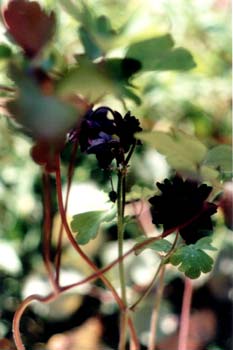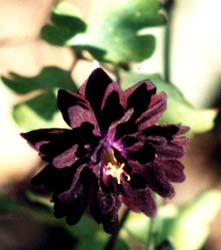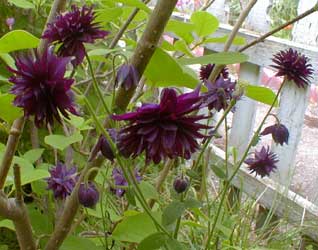
'Black Barlow'
Columbine
"Ye be, as I divine,
The pretty primrose,
The goodly columbine."
John Skelton,
1460?-1529
1460?-1529
In our garden the columbine Aquilegia vulgaris var stellata 'Black Barlow' has bloomed until mid-August, though in most gardens May to June is more usual.
The small flowers are only an inch round on average. They are fully double without evident spurs, so look more like dwarfish dahlia or chrysanthemum pompoms than columbine flowers.
 The deep dark purple coloration is nearly black, making it an item for the Gothic Garden. Just imagine it growing with black pansies underneath the nodding columbine flowers, & black mondo grass nearby, in a garden dominated by black-leafed Diablo Ninebark.
The deep dark purple coloration is nearly black, making it an item for the Gothic Garden. Just imagine it growing with black pansies underneath the nodding columbine flowers, & black mondo grass nearby, in a garden dominated by black-leafed Diablo Ninebark.It seems to like more sun than some columbines & if placed in the shade garden should be situated in whichever section does get more light. Though persistently moist loamy soil is best, it can easily tolerate a little dryness, whereas it seriously dislikes poorly draining soil.
It generally stands less than three feet in height even with the upreaching stems of flowers. The ferny foliage is rather compact with only a foot or foot & a half spread. The blossoms' stems are orange, tending toward purple or maroon, & are occasionally twisted rather than the typical columbine's straight & tall stems.
Although deadheading can extend the bloom time, there is also a certain appeal to permitting columbines to self-seed, as it can be a shortlived perennial dying out of the garden over time if persistent deadheading every year keeps it from seeding. Plus the seedpods are attractive in their own right.
 Varieties crosspollinate freely, however, & if something like 'Black Barlow' is to produce seedlings largely true to self, it cannot be going to seed in the proximity of other varieties. For this reason it was for a long while the only columbine growing on that one side of the house, among many perennials, growing between the picket fence & the Oyama magnolia.
Varieties crosspollinate freely, however, & if something like 'Black Barlow' is to produce seedlings largely true to self, it cannot be going to seed in the proximity of other varieties. For this reason it was for a long while the only columbine growing on that one side of the house, among many perennials, growing between the picket fence & the Oyama magnolia.There remained the possibility of it being pollinated even by more distantly placed columbines, however, & eventually I couldn't stand not having other columbines here & there, so 'Black Barlow' now definitely has nearby cultivars with which it will inevitably cross-pollinate.
So if 'Black Barlow' ever shows signs of declining, I may try to divide it & see if that refreshes the clump; or I will just add another small start of 'Black Barlow' which is frequently available. Some of our columbines are pleasant but not outstanding & if they tired, I'd replace them with whatever other columbine came to hand that seemed nice. But 'Black Barlow' is a memorable priority beauty.
Continue to:
Aquilegia vulgaris plena 'Ruby Port'